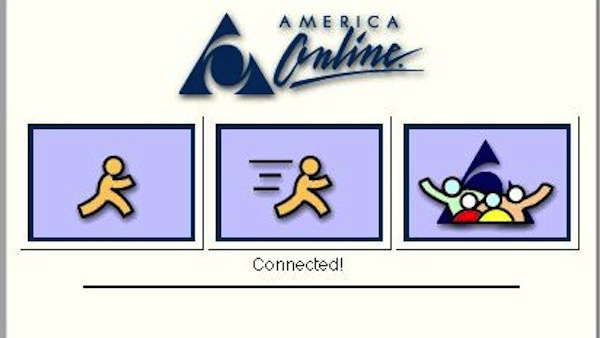AOL: the end of an era, a eulogy
You've got...bought

"You've got mail" [insert AOL voice here]. "Mmmbop" to the sound of unlimited access to AOL Buddy Lists and instant messaging for $19.95 a month. How's that for some nostalgia? But now, the day has finally come to use all those AOL dial-up jokes you've had on reserve since 2001.
The "you've got mail'' announcement that you've been hearing since 2001 has been seen as a throwback to a now bygone era. Verizon announced today that it will purchase (former) internet giant AOL (pending a satisfactory 1,000 free hour trial period, of course).
The $4.4 billion buyout is part of Verizon's plan to dominate two of AOL's technologies: its mobile streaming service - featuring live TV, original shows and pay-per-view - and its ability to automatically send targeted ads to mobile devices. Consider this a eulogy, our dearly beloved.
Remembering AOL
As we look back at the little yellow guy running at the top of our Buddy List, the catchphrase that was a name of sugary-sweet Meg Ryan and Tom Hanks' movie and the uncountable AOL startup CDs - AOL spent a fortune producing these CDs, AOL executives admitted on Quora - we need to remember how this company changed the digital market space and how people accessed and used the Internet.
America Online gave many people their first email address, let them read their first articles online, and gave them their first experience playing games, shopping and chatting with others in a digital space.
It is one of the oldest brands on the Internet, synonymous with much of the Web's early initiatives, including email, instant messaging and of course dial-up Internet access (with two million people still subscribing, yes, really). Little did the company know it was paving the way for it's own death, as today's social networks, which would not exist without deriving some wisdom from AOL's trailblazing, essentially killed the service.
The good old days
Although the AOL days are now dead and gone, we're taking a trip down nostalgia lane because AOL's signature technologies will live on.
Sign up to the TechRadar Pro newsletter to get all the top news, opinion, features and guidance your business needs to succeed!
AOL Mail: We will never forget the day we created an aol.com email address and the joy it brought to our hearts. It was like a right of passage, a way to feel important every time we did get mail on the computer. The more clever, the better (Icausetraffic@aol.com).
There are still some people who use AOL's mail service today, which probably means they also have a Hotmail account, but AOL mail is convenient. It certainly paved the way to Gmail and Yahoo mail.
Aim: America Online's instant message software was ahead of its time, think of it as a combination of Snapchat and Whatsapp before there was a Snapchat or Whatsapp. Incoming messages would appear on our PCs, as we sat glued to our seats waiting to see who was signed on to AIM and up for chatting.
AIM's chat tool preceded Google's early instant messaging service in 2005 and Facebook's own chat, which was introduced in 2008. Facebook also tried to create it's own internet and took a page out of AOL's playbook, integrating chat to its services to connect with friends, family and colleagues. Skype took the idea further by offering free video chat. Why type when you can just talk into your Web cam?
AOL is now worth less than a quarter of WhatsApp, a six-year-old mobile messaging service that also gained worldwide popularity through word-of-mouth. (We'll get back to you about Snapchat valuations another day.) Sadly, AOL didn't anticipate the coming era of social networks and, eventually, mobile devices.
Today companies are doing similar things, with upgrades and better software technology. Just look to Slack, HipChat and Gchat. Now you can reach anyone, anywhere, as long as the person on the receiving end is also signed in on their phone with a mobile app.
MapQuest: Remember the site we used before GPS? AOL acquired Mapquest in 2000, and it's a service that people still use today. It's safe to say that Google Maps followed suit and came out with an even better product.
Different AOL
Today AOL is a much different company than it was 15 years ago, when the Internet portal agreed to merge with Time Warner Inc. It was one of the largest mergers at the time, and it also became one of the largest failures.
With little chance of jumping into the digital space and in quiet desperation, AOL fell along with many other tech companies during the dot com bust. Subscribers left its dial up service for faster Internet access from internet providers.
Still, AOL came out strong. It succeeded - or at least AOL succeeded enough for Verizon to commit billions for what is essentially being called a deal for advertising technology. As a standalone company since 2009, AOL has gotten further away from its e-mail roots - it has built a mobile streaming service, featuring live TV, original shows and pay-per-view.
The deal gives Verizon new revenue streams at a time when its main business faces increasing competition from challengers such as T-Mobile. It's also focused on advertising technology, becoming a smaller challenger to the ad giants that Google and Facebook have become.
It's a bittersweet day for those working in tech and those people reporting on tech at the Huffington Post, TechCrunch, Engadget and their affiliated media brands. All three blogging giants were given - to a degree - editorial freedom to operate independently from the rest of the AOL company, or at least that's what we're led to believe. Only time will tell what it will be like working for an even bigger corporation.